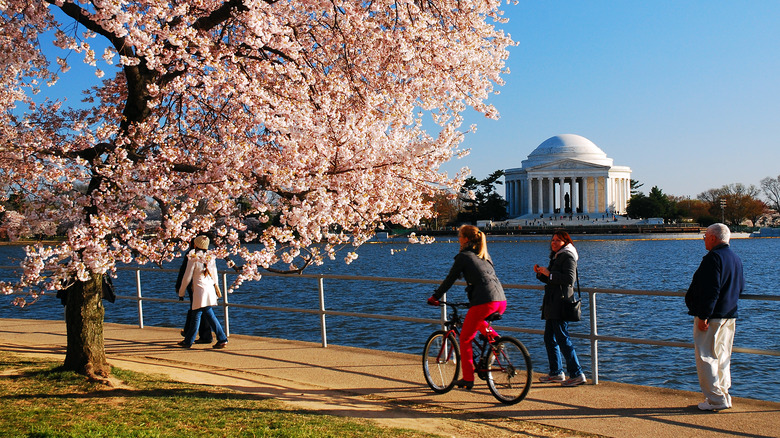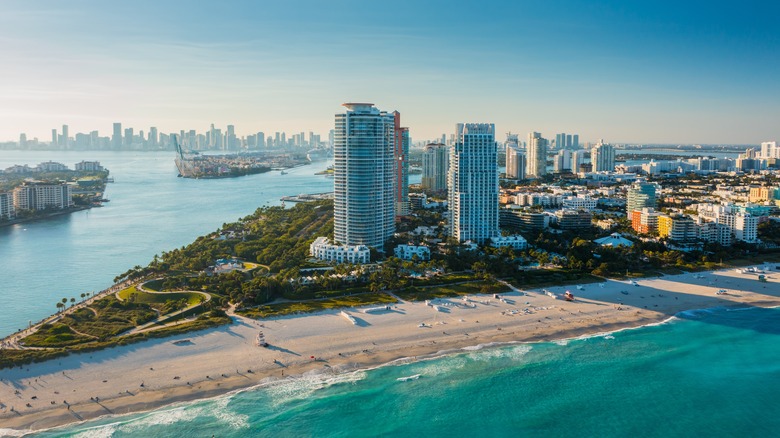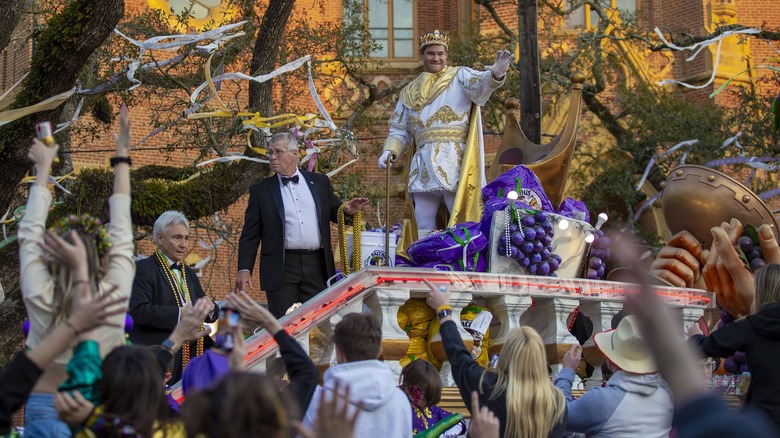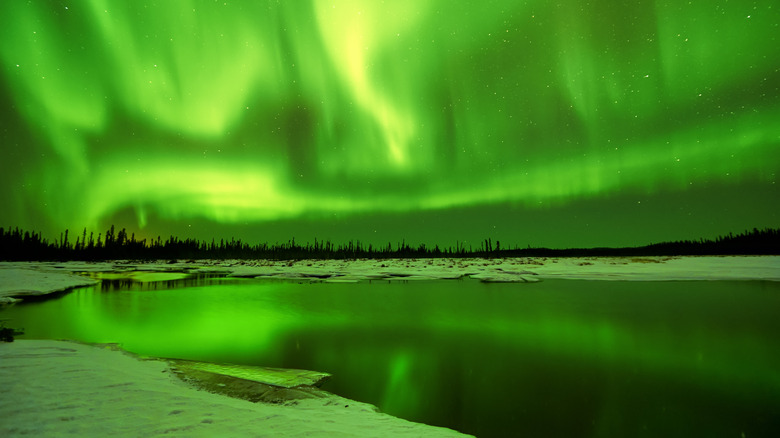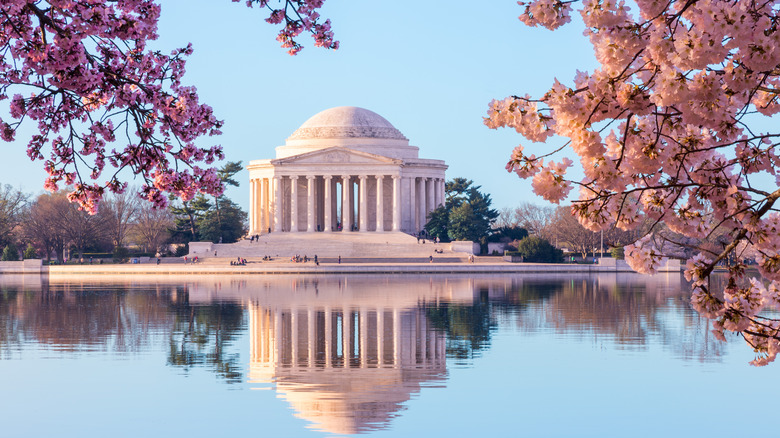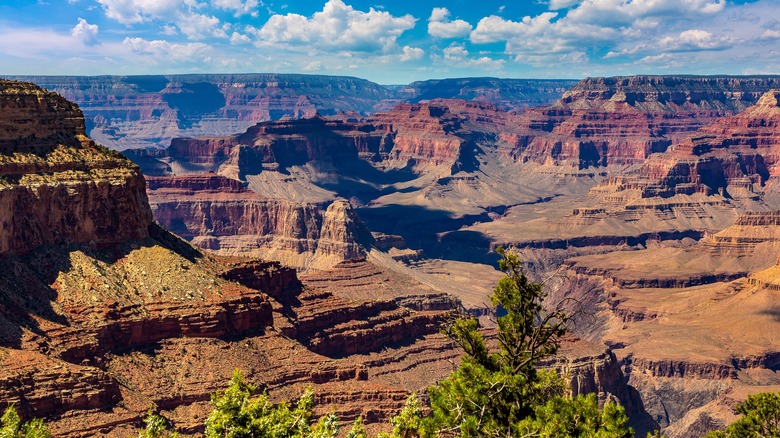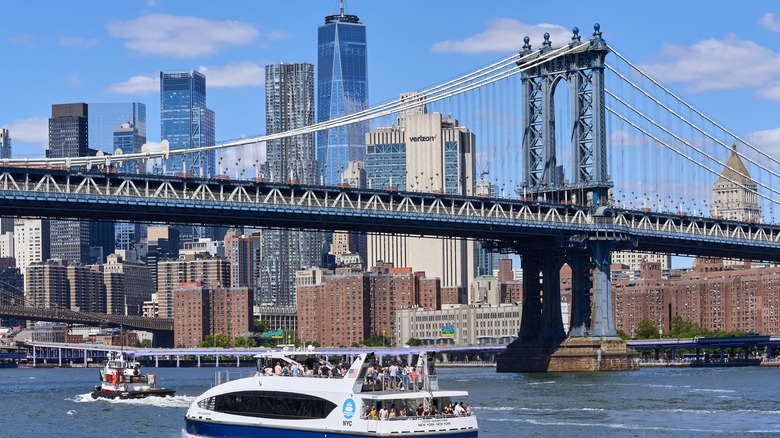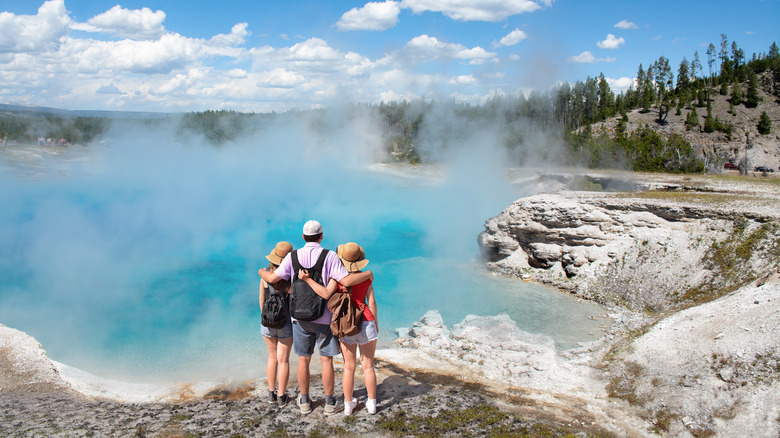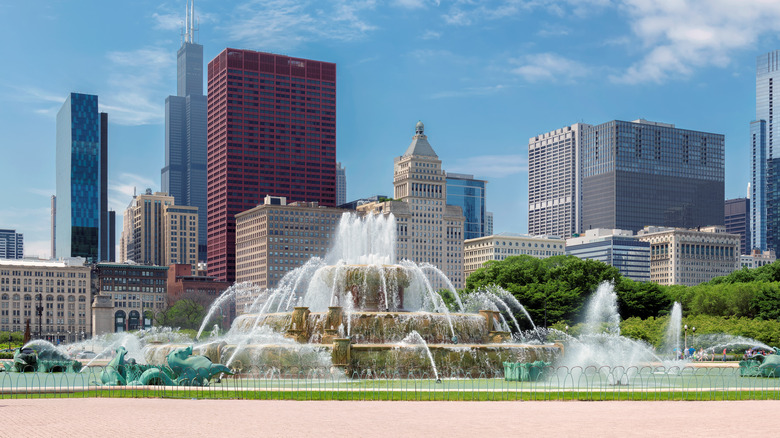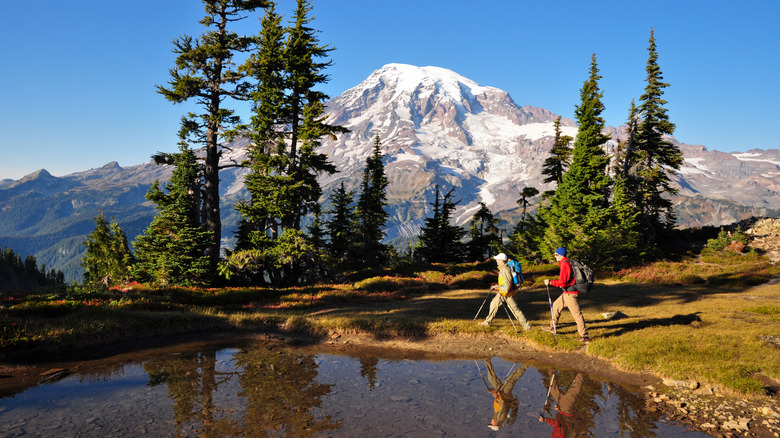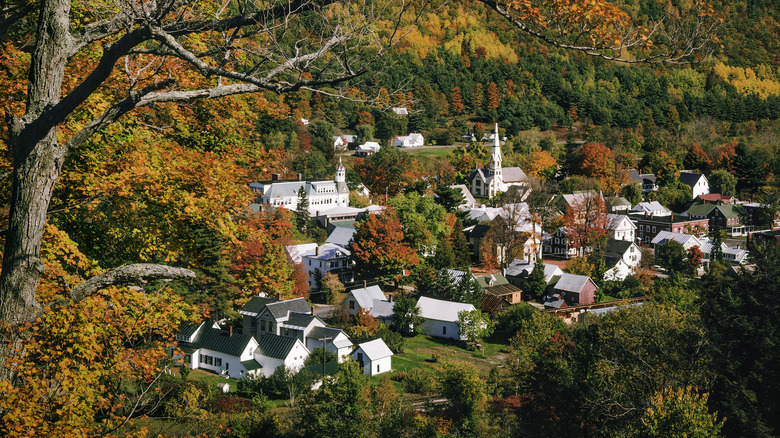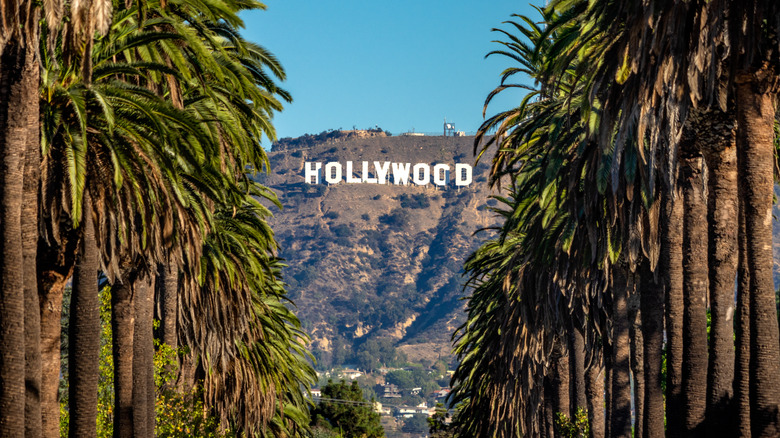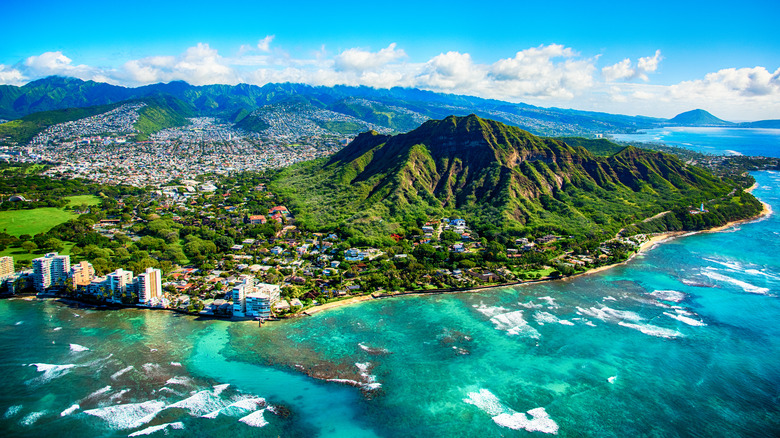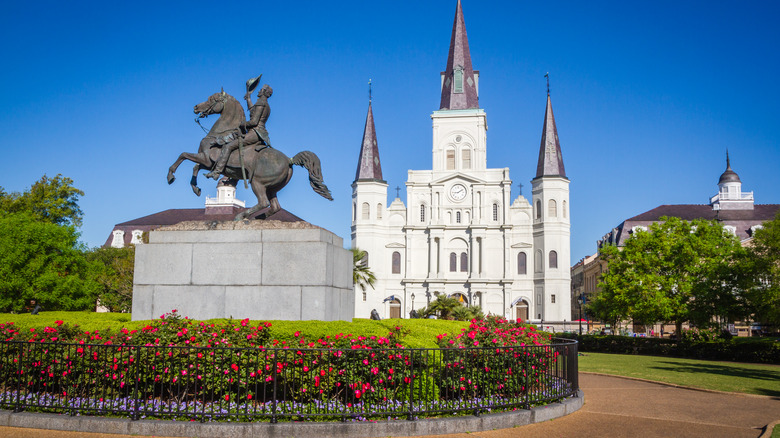The Best Places To Visit In America By Month, According To Travelers
One of the important factors for any travel excursion is getting the timing right. Level up your next vacation by visiting a destination when it has perfect weather, smaller crowds, lower prices, or holds popular annual events. To create a list of the best places to travel every month, we've pulled from personal experience, as well as advice from tourism boards and local experts.
Some places are worth visiting during specific times to see the wonders of nature — for instance, the spring arrival of the cherry blossoms in Washington, D.C., or the beautiful autumn colors in the Northeast. Others become attractive destinations due to smaller tourist crowds at specific times, such as the Grand Canyon in May or Miami in January. And a few places are worth braving larger crowds during peak season, because of the atmosphere — like Fat Tuesday in New Orleans in February and the many festivals in Chicago in August.
It's important to match the timing of a destination with your interests. For instance, Yellowstone in winter can be an awesome experience for tourists interested in wildlife and winter scenery. But hikers who want to experience some of the park's best mountain trails should wait until summer. Mark your calendars and start planning your next year's trips by considering the top spots in the U.S. to visit in each month of the year.
January: South Florida
January in Miami typically sees great weather, with little rain and average high temperatures around 75 degrees Fahrenheit. Spring break crowds start arriving to Miami and South Florida in late February and March, so unless partying with college students is your vibe, coming in January makes a lot of sense.
Spend time in South Beach, enjoying the beaches and exploring the shops, rooftop bars, and restaurants of Ocean Drive. Elsewhere in Miami, hang out in the historic Little Havana neighborhood to experience a taste of Cuban culture, wander the Wynwood Walls museum of street art murals, visit the Miami Design District neighborhood for innovative architecture and art galleries, and tour the Vizcaya Museum and Gardens, which houses a historic mansion and 10 acres of gardens.
Don't overlook other appealing destinations in South Florida if you've got the time. Check out the alligator-laden marshes and manatee-filled waterways of Everglades National Park. Or, drive to the southern tip of Florida to hang out in the quirky city of Key West, which has January events like the Key West Food and Wine Festival. And consider often-overlooked Dry Tortugas National Park, a series of islands off the coast of Key West with great snorkeling and the Civil War-era Fort Jefferson.
February: New Orleans
Mardi Gras in New Orleans is one of the wildest events of the year, as New Orleans comes alive with costumes, parties, and parades. The full Mardi Gras season lasts for weeks, but the biggest celebrations take place on Fat Tuesday. Fat Tuesday is always 47 days before Easter and one day before Ash Wednesday. Usually, that means it falls in February, although it occasionally lands in early March. See Mardi Gras New Orleans for the exact dates for Fat Tuesday in upcoming years.
Book your New Orleans lodging early, because hotels fill up quickly for Mardi Gras. To immerse yourself in the middle of the action, try to find a hotel near the French Quarter and Bourbon Street, or at least one within walking distance of a streetcar line.
Even without Mardi Gras, New Orleans is one of the great cities in the U.S., with its rich history, architecture, food, and music. When you're ready to escape the bead-tossing madness of Mardi Gras, stop into one of the many jazz clubs around town, and check out the elegant mansions of the Garden District and the colorful houses of the Bywater and Faubourg Marigny neighborhoods.
March: Alaska
Summer may be best for an Alaska road trip through Anchorage and Denali National Park, but winter is ideal for one specific purpose: seeing the aurora borealis. The Northern Lights are visible from late August through April, and Fairbanks is the ideal place to view them.
While there's never a guarantee that visitors will see the Northern Lights, Explore Fairbanks says that when the sky is clear and dark enough, the lights should be visible four out of every five nights this time of year. Visitors have several ways to see the lights, which include evening snowmobile tours and driving up Alaska's Dalton Highway.
Fairbanks has direct flights from places like Chicago and Seattle, and you'll need to bundle up while you're here. Low temperatures can drop below zero in Fairbanks at this time of year, and they're even colder at night, when you'll need to be out to see aurora activity. That said, March in Fairbanks is actually warmer than January and February, and it sees much less snow, so it's the best option for tourists. If you get a chance to witness those brilliant colors dancing around the night sky, enduring the chilly weather will be worth it in the end.
April: Washington, D.C.
The cherry blossom bloom in the nation's capital is one of the most popular spectacles of nature. Every March and April, for just a few weeks, the Yoshino cherry trees reveal their pink and white flowers, drawing onlookers from across the country. The flowers can reach their peak bloom season anytime from mid-March to mid-April. Historically, the mean date for peak blooms is April 4, so planning a trip during the first week of April seems like the smartest move if you need to book in advance. Warm winters accelerate the start of cherry blossom season earlier, while cold winters delay it. Follow the National Park Service, which makes updated peak bloom predictions as spring gets closer.
Once you make it to D.C., find the cherry blossoms around the Tidal Basin, next to famous landmarks like the Jefferson Memorial, Roosevelt Memorial, and Martin Luther King, Jr., Memorial. Additional flowers grow around the Washington Monument, Lincoln Memorial, and in West Potomac Park. See the official map from the NPS. You can also attend the events of the National Cherry Blossom Festival, which was created to celebrate the annual bloom. The festival centers around the flowers but also includes kite-flying events, a fireworks show, live music, and a parade.
May: The Grand Canyon
U.S. News & World Report suggests that March through May is an ideal time to visit the Grand Canyon, for several reasons. Start with beautiful weather, featuring average highs around 70 degrees Fahrenheit and only a half-inch of rain all month. The summer crowds haven't yet arrived, so you can enjoy the remarkable views without having to battle masses of tourists for hotel reservations and viewing platform space.
Visiting the Grand Canyon means choosing a side. The North Rim and South Rim are separated by about 21 miles via hiking trail, but in driving distance, they're 220 miles and 4.5 hours apart. The National Park Service says that only 10% of Canyon visitors see the North Rim, so that side can be appealing for folks who want to get off the beaten path. But because the North Rim sits at an elevation of more than 8000 feet, it closes during the winter due to snowfall and only re-opens in mid-May. The South Rim is open year-round. Keep this in mind when arranging a visit.
Surely, you don't need to be sold on the reasons to visit this legendary American attraction and natural wonder, but things to do at the Grand Canyon include hiking, rafting through the Canyon, and taking a bike tour. If you're brave enough, try the Grand Canyon Skywalk, a glass platform that extends out over the Canyon.
June: New York City
There's never a bad time for a vacation in the Big Apple. Many New Yorkers believe that spring and fall are the ideal times to visit, but summer is great, too. That's when one of the world's most vibrant cities somehow becomes even more exciting.
From the Puerto Rican Day Parade to the Tribeca Film Festival to the LGBTQ+ Pride March, New York City has a bunch of fun festivals and events in June. There's also the Governors Ball Music Festival, the live theater performances of Shakespeare in the Park, and the Taste of Times Square, a popular restaurant festival. Bryant Park also hosts picnic performances and outdoor movie nights all summer, starting in June.
June typically provides comfortable temperatures and long hours of daylight to walk around the city, visit tourist attractions, and get to know the city's many vibrant neighborhoods. This time of year is great for exploring Central Park, visiting the Edge sky deck, walking the High Line rail trail, and seeing the Statue of Liberty. Also consider some underrated NYC attractions that you may not have heard of, like Fort Wadsworth, Socrates Sculpture Park, and the Ukrainian Museum.
July: Yellowstone National Park
Generally considered the world's first national park, Yellowstone is a bucket-list destination for many Americans. Mostly located in Wyoming, the park holds numerous geothermal points of interest, from the Old Faithful geyser to the collection of thermal vents of Mammoth Hot Springs. By July, most of the snow in Yellowstone has melted and all park roads are open, so visitors can explore the park to its fullest.
Tourist crowds are fairly large in July, but the park is big enough to accommodate thousands of tourists. View the vibrant colors of Grand Prismatic Spring, take in the majesty of the Grand Canyon of Yellowstone, drive through Hayden Valley in search of bison, visit the Mud Volcano area of bubbling mudpots, and hike to the summit of Mount Washburn at Dunraven Pass, keeping an eye out for grizzly bears.
Ideally, you'll want to give yourself at least three days to explore the park, since it covers more than 2 million acres. That will provide enough time to drive the entire Grand Loop Road and spend some time at Yellowstone Lake, the largest high-elevation lake in the U.S. If you decide to plan a July visit to Yellowstone, book lodging as far in advance as possible, since park lodges and nearby hotels begin to fill months ahead of time.
August: Chicago
Chicago in the summer is hard to beat. August temperatures in the Windy City can get pretty high, but braving the heat is a small sacrifice to take part in the many neighborhood street fairs and city-wide festivals going on.
Start with the Air and Water Show, a free, two-day event on Lake Michigan that attracts thousands of spectators to watch aerial performers like the U.S. Army Parachute Team Golden Knights and various teams from the Air Force and Air National Guard. One of the most well-known music festivals in the world, Lollapalooza takes place in Grant Park over four days in early August, bringing a diverse musical lineup covering all genres of popular music, including acts like Metallica, Kendrick Lamar, and Lana Del Rey. Popular culinary festivals in August include Ribfest Chicago, Taste of Greektown, and the Great American Lobster Fest.
You can also take advantage of the opportunities for outdoor fun in summertime Chicago, from enjoying the 26 miles of free public beaches to kayaking on the Chicago River and jet skiing on Lake Michigan. Take a ride on Chicago's famous architecture cruise, a boat tour on the Chicago River that offers cool city views from the water and features narration about the history of Chicago and its famous skyscrapers.
September: Pacific Northwest
Whether you prefer to head to the forest for some national park hikes or explore the urban landscapes of Seattle and Portland, late summer and early fall are great times to experience the Pacific Northwest. Temperatures remain warm, and though rainfall starts to pick up a bit as the month goes on, the odds of enjoying a sunny day in September in the region are much higher than in October.
For Seattle tourists, this means clear views from the Space Needle and pleasant weather for visiting Pike Place Market. In Portland, walk around the Pearl District or Mount Tabor Park, and view the roses that are still in bloom at the International Rose Test Garden. The coastal towns are also worth exploring in September. See the famous Haystack Rock landmark near Cannon Beach, Oregon, or rent a fat bike and ride on the sand next to the ocean in Ocean Shores, Washington. The peaks in Mount Rainier and Olympic National Parks have some of their lowest snow cover of the year in September, so all the major trails are accessible to hikers.
Late September is typically the start of larch season, when western larch trees in the mountains turn from green to bright gold. It's an annual occurrence that Pacific Northwest hikers look forward to all year, and it only lasts a few weeks. Washington Trails Association notes that North Cascades National Park has some excellent larch hikes, such as Cutthroat Lake and Easy Pass.
October: New England
The Northeast states are renowned for their fall foliage. Even if you've seen the photos of hillsides full of bright red, orange, and gold leaves, seeing the colorful trees in person is a thrill. Mid-October usually offers peak colors, but the exact timing of the color change can vary. Northern Maine will obviously have a slightly different season than areas farther south like Connecticut and Rhode Island. Travelers can use the fall foliage map on Newengland.com to estimate when leaf activity will peak in a particular region.
What specific areas of New England should tourists consider visiting in October? Town & Country has some suggestions, including Lake Winnipesaukee Loop in New Hampshire, Route 100 in Vermont, Route 1 along the coast of Maine, and Massachusetts Route 6A on Cape Cod. Maine's Acadia National Park is another great place to see the autumn colors. The park has several elevated points that provide sweeping views of the surrounding forests, including Cadillac Mountain, the first place in the U.S. to see the sunrise each morning.
If you've got the time, taking an October road trip through New England can be a great way to see the wonders of nature and explore tourist sights, such as the Mark Twain House in Connecticut, the Ben & Jerry's factory in Vermont, and the many famous historic attractions in Boston.
November: Southern California
November is a good time to go to Los Angeles, as high temperatures still average above 70 degrees Fahrenheit all month. Get outside and explore the Santa Monica Pier and Venice Beach, hike in the Hollywood Hills, window-shop with the rich and famous in Beverly Hills, or find your favorite celebrity stars at the Hollywood Walk of Fame. You can even ice skate in Downtown L.A. on a temporary ice rink set up for the holiday season! Other November events in L.A. include West Hollywood Eat + Drink Week, the Los Angeles Auto Show, and the Manhattan Beach Pier Lighting to kick off the Christmas season.
If you're interested in including Disneyland in your visit, the Anaheim park says that crowds are smaller throughout the fall, since most kids are in school, so November is a good time to visit, as long as you come in advance of the Thanksgiving holiday. November is also a pleasant time to visit the desert environments of Joshua Tree and Death Valley National Parks, where temperatures can be scorching during the summer. The same holds true for the desert oasis of Palm Springs, which sees comfortable weather and well-attended events like the Greater Palm Springs Pride Festival in November. And San Diego is fun any time of year, with its great beaches, parks, aquatic activities, and zoo.
December: Hawaii
December is the time for a warm-weather getaway, and Hawaii is a perfect choice for this, especially if you can visit during the beginning of the month. Hawaiian Airlines notes that tourist crowds increase quite a bit starting in mid-December, and flight prices obviously increase the closer you get to Christmas. Coming during the beginning of the month is a good way to get better prices and a less hectic experience on the islands. Enjoy the gorgeous beaches and scenic volcanoes that make Hawaii a paradise to so many travelers.
December 7 is the anniversary of the attack on Pearl Harbor that started U.S. involvement in World War II. Every year, locals and tourists take part in a series of activities on National Pearl Harbor Remembrance Day. This includes events at Pearl Harbor National Memorial and a Memorial Parade in Waikiki with veterans, marching bands, and cheerleading teams.
Travelers who don't mind paying a bit more to visit during the holidays can celebrate the season with events on every island, such as the Waimea Christmas Twilight Parade (Big Island), Waikiki New Year's Eve Fireworks (Oahu), Honolulu City Lights (Oahu), and a New Year's Eve Cocktail Cruise (Maui). Various resorts and bars on the islands also hold celebrations to ring in the new year.
Methodology
This article was compiled using a combination of resources: personal experience at all of the destinations chosen, weather and climate websites that track average annual temperatures and precipitation, and the advice of local tourism boards and companies based in these regions.
Explore Fairbanks, for instance, provided information about the best time to visit the city to see the Northern Light. Hawaiian Airlines gave advice on the best time of year to visit Hawaii while providing a list of December activities on the islands. Weather Spark and weather.gov both served as a resource for historic climate and weather information for these destinations.
Personal experience provided the basis for selections such as Miami in January, Chicago in August, and the Pacific Northwest in September, as well as all of the related activities associated with those months.
